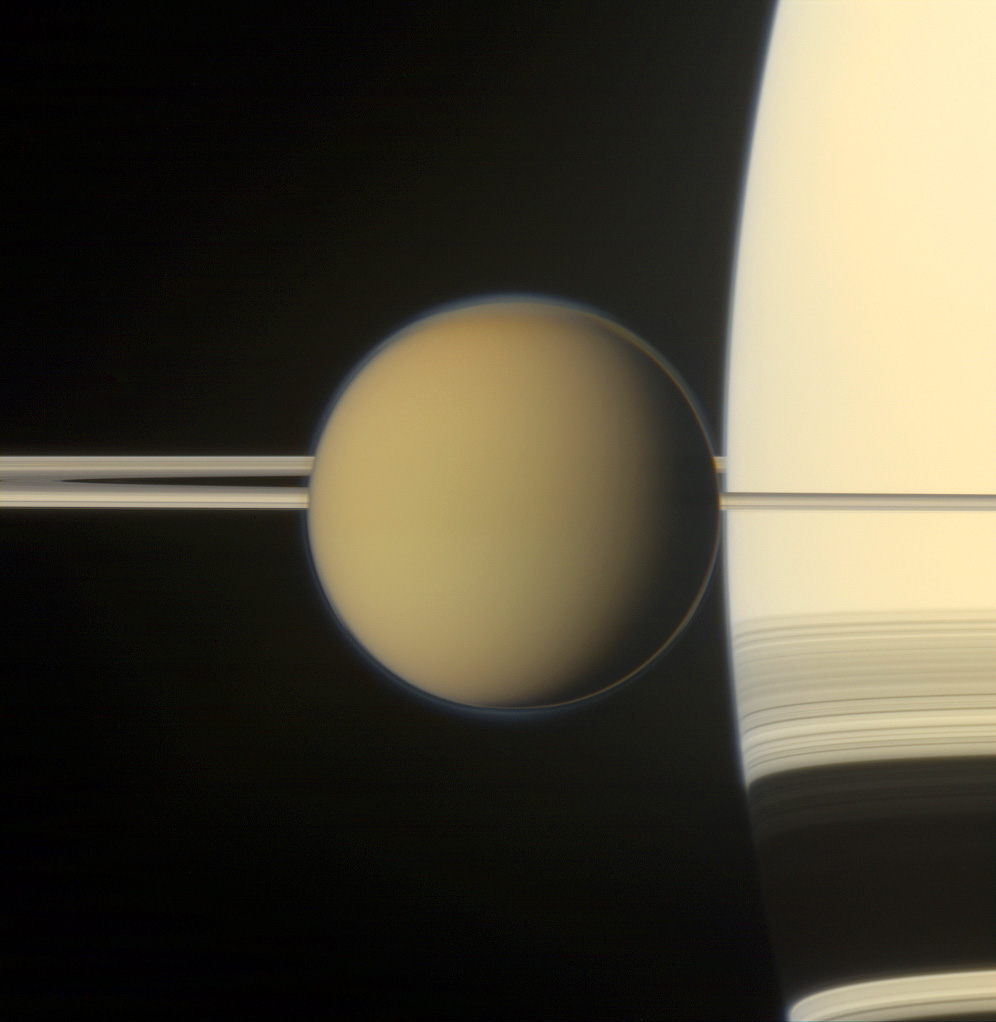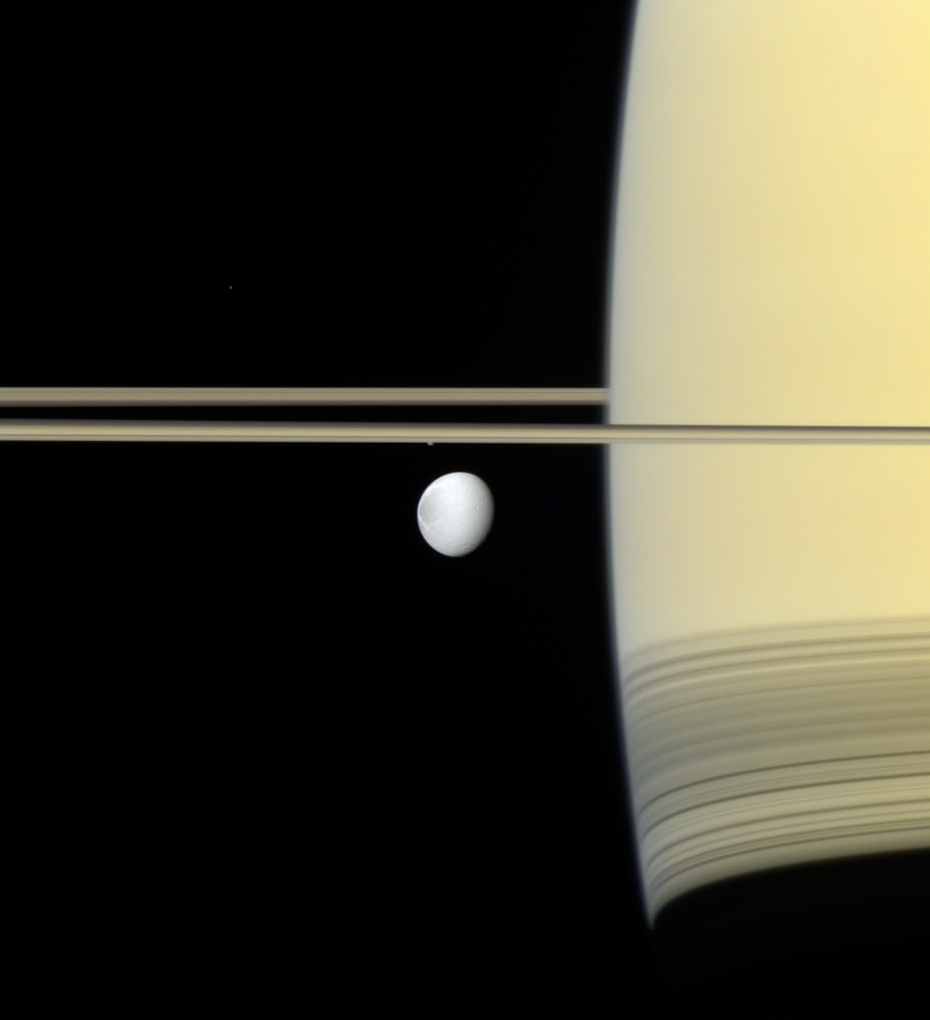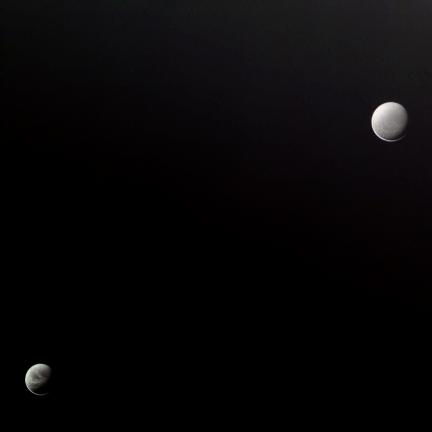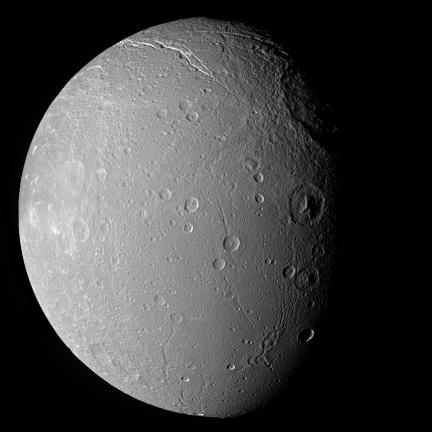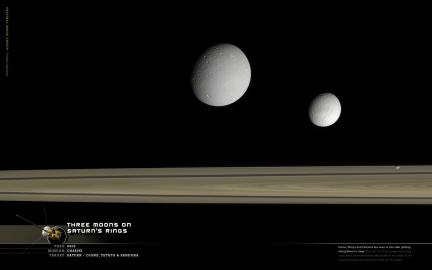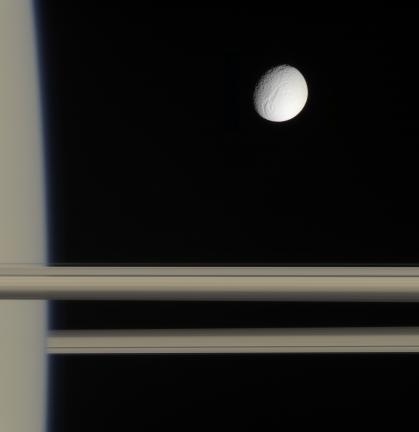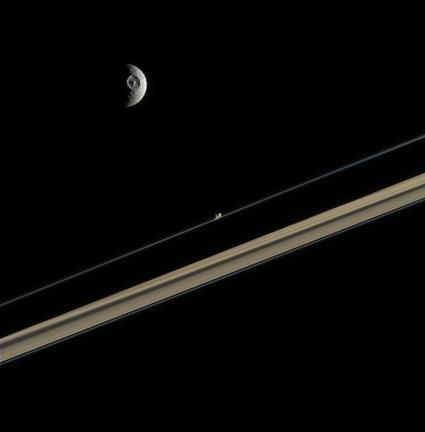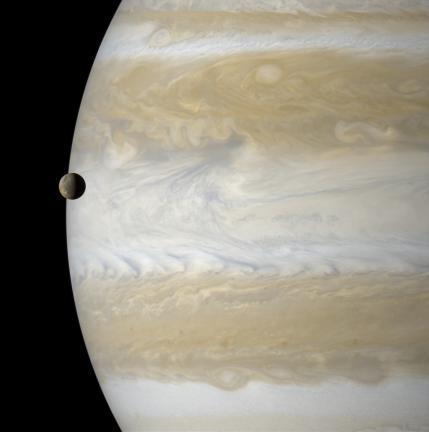Around Saturn from fabio di donato on Vimeo.
In Saturn’s Rings Official Trailer
The long awaited official trailer for “In Saturn’s Rings” has been unleashed. Looking forward to this film for over three years now.
Best of G. Ugarkovic (Last 8 Months)
If you follow this blog on any basis, you might be well aware that a good percentage of the imagery is provided by our good flickr friend Gordan Ugarkovic. Here is a bit of what we missed from him in the last 10 months we were locked out.
Titan at the edge of Saturn taken 2011-05-21. Looks unreal. Like Titan was dropped into the scene using Photoshop. A sin I would never commit. See the lesser “official” NASA version released a few months back here.
Keeping with the theme of moons transiting Saturn. Here is Rhea and tiny Epimetheus doing what they do. Taken in 2010-03-24.
Finally, just to change it up… two moons against Titan, another of Saturn’s moons. Pictured above the Titanian cloud-tops is Dione on the left and Rhea on the right.
Titan and Friends
Titan and friends from recent official Cassini mission releases.
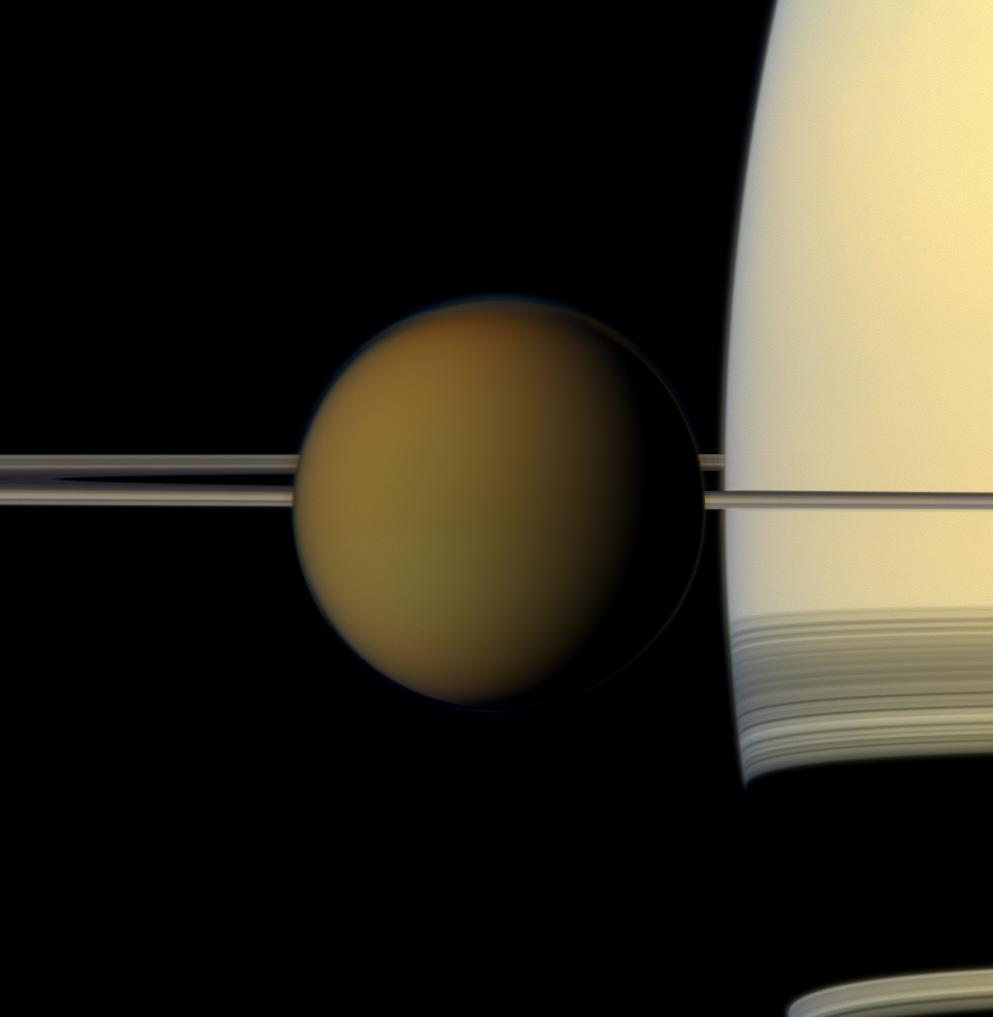
Shown with Saturn
Shown with Dione against a Saturn and rings nearly edge-on in the background. Looks like a NASA re-interpretation of this image.
With Tethys against more edge-on rings.
Dione and Saturn
A New Work of Art
 We may have a new best of Cassini shots with this one. The color composite was executed by Ian Regan who was the creator of another Cassini favorite here at wanderingspace.
We may have a new best of Cassini shots with this one. The color composite was executed by Ian Regan who was the creator of another Cassini favorite here at wanderingspace.
50 Years of Space Exploration Map
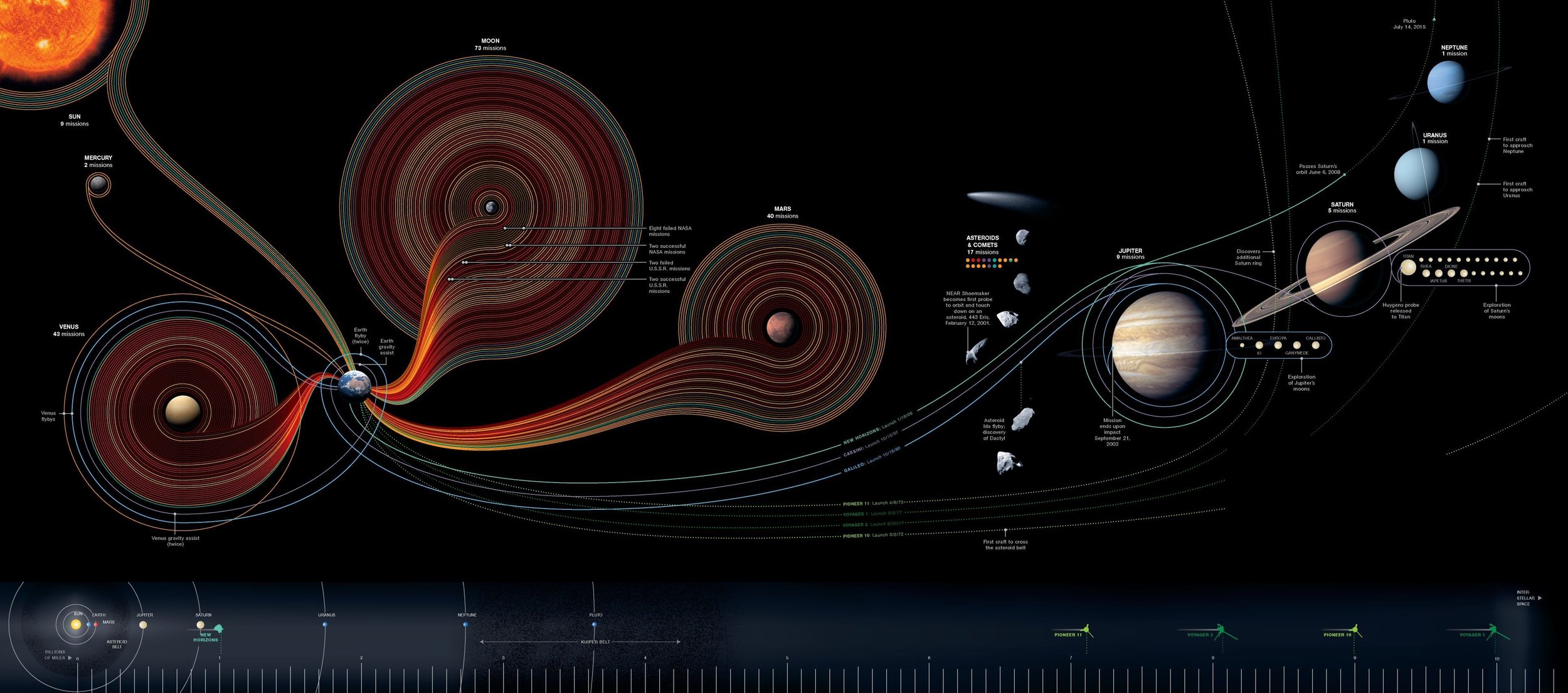 This is so nice, but I am furious that I didn’t get to design this. This is Information design at it’s best naturally by National Geographic. You can see 50 years of robotic planetary exploration at a glance. It even includes failed missions represented by darker desaturated lines. As far as I can tell the cream colored lines are US and the red ones are Soviet. Interesting to see how many of those lines go dark around Mars.
This is so nice, but I am furious that I didn’t get to design this. This is Information design at it’s best naturally by National Geographic. You can see 50 years of robotic planetary exploration at a glance. It even includes failed missions represented by darker desaturated lines. As far as I can tell the cream colored lines are US and the red ones are Soviet. Interesting to see how many of those lines go dark around Mars.
Now where does one purchase such a thing? Perhaps this month’s issue of NG? Here is the link to it on their site complete with zoom viewer and them some kind samaritan posted a hires version to flickr.
Saturn Through the Eyes of Hubble
On the Way to Enceladus
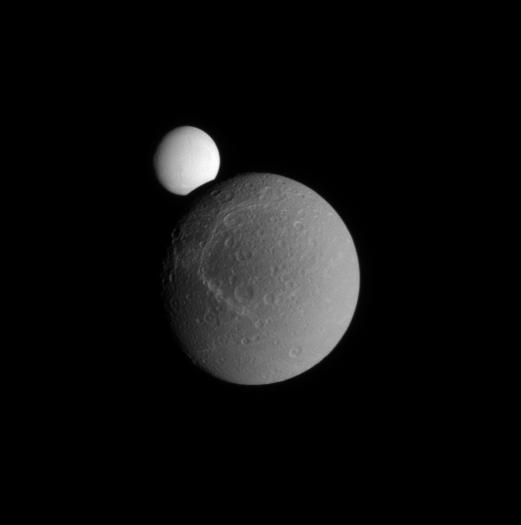 There was another up-close buzz over the plumes of Enceladus yesterday. Apparently the science team has been mum about the previous close shave a few weeks ago because they want to do a combined press release on both encounters.
There was another up-close buzz over the plumes of Enceladus yesterday. Apparently the science team has been mum about the previous close shave a few weeks ago because they want to do a combined press release on both encounters.
The above image taken Oct 28, is a real nice warm up shot taken on its way to the encounter with Dione in the foreground.
Rhea and Dione, So Happy Together
2560 x 1600 Set 05 : Saturn Scenes
Among the various worlds in our celestial neighborhood, Saturn stands apart as a most photogenic. With the help of a complex system of rings it naturally lends itself to more scenic images as compared to the more detail oriented images we see from such other places such as Mars or Jupiter. The “Saturn Scenes” set (downloadable here as a zipped file) was compiled from some of the best scenic images from the Cassini mission that had the potential to fill a 2560x1600 frame.
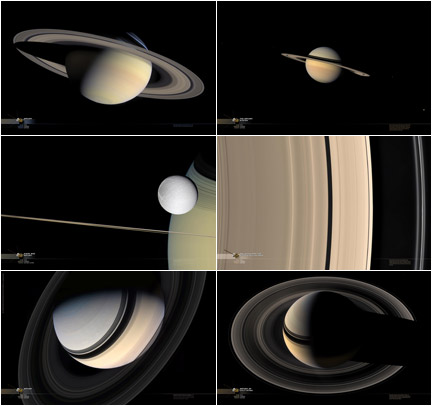
In order to completely fill that frame out some rendering and sampling has been applied to the original images. These additions are briefly noted in the images themselves and are as noted here…
DIONE AND SATURN features the moon Dione passing in front of the edge of Saturn’s disc. The original image would only fill about 1/4 of the frame so some of the details have been sampled and expanded to fill out that full frame’s proportions. The details of the rings are sampled from this image and based upon other photographic references. The left 2/3 of the rings seen here were rendered and are not actual. The lower 1/5 of Saturn’s disc was sampled and extended from the original image. Lastly, the top darkest ring shadows were rendered based upon a fair amount of actual data that was actually present in the original but was cropped short.
SATURN (which is named “SATURN-2.jpg” in the file name) has had a considerable amount of rendering to extend the details of the rings to fill out this larger 2560x1600 frame. The original color composite work was masterfully performed by Ian Regan for unmannedspaceflight.com and has become a wanderingspace favorite. In order to extend the rings to fill out the frame as accurately as possible, a one pixel wide sampling of the full set of rings was captured and digitally translated to vectors. These vectors were then stretched and applied to a circle path which was then rendered in 3-D software to achieve the correct perspective of the original. Once a match was made, the new vector based rings were then blended into the actual original image and some masking was applied to represent Saturn’s shadow falling upon the rings. Despite the heavily rendered nature of the rings, virtually no part of the disc of Saturn itself has been altered and is 99.5% original and actual.
All other images are actual and unaltered.
Cassini Team Shows Some Color
NASA released an unusually large amount of color images to the Cassini website recently. Most of what is shown here on this site are actually images put together by freelance imagers who access the raw files and do some stitching together of filtered images. Color images coming straight off the Cassini website are a rare event, so when about 8 appeared in the gallery a few days ago… it was an unexpected gift.
 Saturn as seen from the unlit side of the rings.
Saturn as seen from the unlit side of the rings.
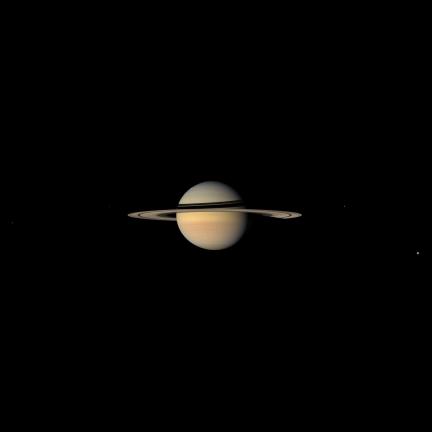 A family portrait of the Saturn System. Moons visible in this image (you need to click the preview) are Dione at far left, Enceladus near the left side ring edge, Mimas a speck on ring shadows on the western limb, Rhea against the northern hemisphere, Tethys near the right ring edge, and Titan near lower right.
A family portrait of the Saturn System. Moons visible in this image (you need to click the preview) are Dione at far left, Enceladus near the left side ring edge, Mimas a speck on ring shadows on the western limb, Rhea against the northern hemisphere, Tethys near the right ring edge, and Titan near lower right.
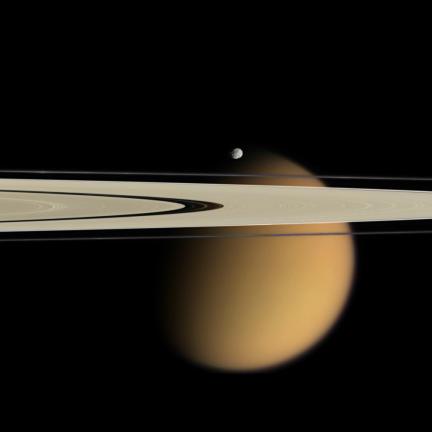 Titan and a small moonlet named Epimetheus share the frame with Saturn’s rings.
Titan and a small moonlet named Epimetheus share the frame with Saturn’s rings.
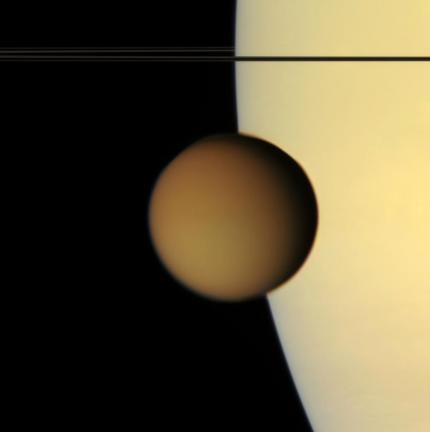 A rare color view of both Saturn and Titan in one frame. This is the only one of its kind thus far in the mission.
A rare color view of both Saturn and Titan in one frame. This is the only one of its kind thus far in the mission.
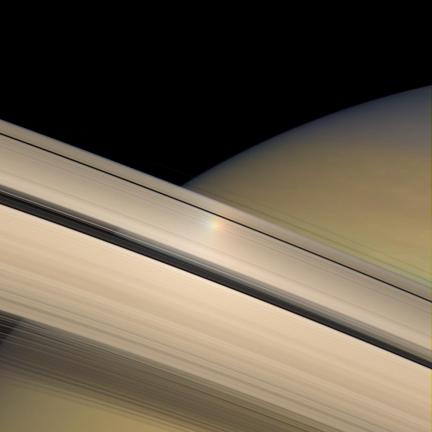 A small rainbow appears as sunlight streams through Saturn’s rings.
A small rainbow appears as sunlight streams through Saturn’s rings.
Saturn and Titan Animation by U. Gordan
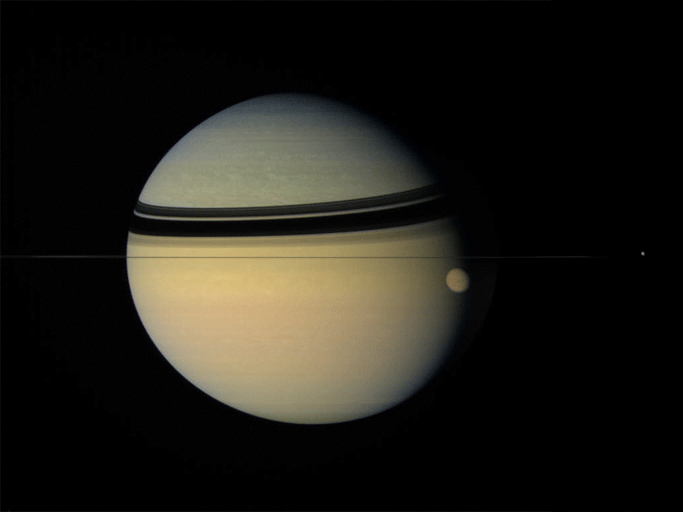 Officially this site’s most mentioned personality, Gordan Ugarkovic does it again with a series of color images combined to show an hour at Saturn. In addition to this being a gorgeous animation, the very image of Saturn and Titan in the same frame has thus far, in and of itself, been quite a rarity in the Cassini mission. The other moon visible in the shot is Dione.
Officially this site’s most mentioned personality, Gordan Ugarkovic does it again with a series of color images combined to show an hour at Saturn. In addition to this being a gorgeous animation, the very image of Saturn and Titan in the same frame has thus far, in and of itself, been quite a rarity in the Cassini mission. The other moon visible in the shot is Dione.
Original image appears on the unmannedspaceflight forum.
Active Bodies List: Dione and Tethys
For those keeping score… the active bodies in the Solar System list may now include Dione and Tethys at Saturn. See article here - spacespin.org.
Dione: A Quick Composite
I noticed some recent images taken of Dione would make a nice hires if one were to stitch them together. Of course, these images were each (4 of them) taken at different times and therefore, the cassini spacecraft was at different vantage points (see the original 4 images below).

So matching them up is not quite as simple as lining up a few repeat details from one to the next, but photoshop gives one some powers of distortion to make up for some of that. The biggest issue was the disc edges – for when they didn’t match up (and they didn’t) all there was for me to do was to draw a circle and erase. I cannot match the technical skills of some of the freelance imagers that I have featured on the right, but its fun making myself a nice large scale image of one of Saturn’s larger moons.
Wallpaper: Dione’s Ice Cliffs at Crescent
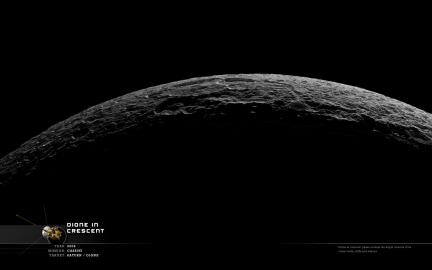 An almost Apollo class image of the cliffs of Dione rising at its horizon. Many of the cliffs pictured here are from impact craters, but Dione is also well known for its “wispy” details which have been revealed by Cassini as fractures which result in giant ice cliffs and valleys. You can see one crater actually cross-sectioned by one of these fractures at the extreme far right side of the wallpaper image above.
An almost Apollo class image of the cliffs of Dione rising at its horizon. Many of the cliffs pictured here are from impact craters, but Dione is also well known for its “wispy” details which have been revealed by Cassini as fractures which result in giant ice cliffs and valleys. You can see one crater actually cross-sectioned by one of these fractures at the extreme far right side of the wallpaper image above.
The origins of these fractures are yet unknown and it is generally accepted that these are relatively recent formations as many of them run through impact craters which are known all over the solar system to be ancient details. As a matter of fact, impact cratering is how most planetary scientists are able to rate the age of a surface by the absence or presence of crater events. Bodies with many craters (our moon, Callisto and Mercury) are considered to be old and generally unchanged since early in its formation history as it is assumed that the period of heavy cratering happened soon after the formation of the solar system. Bodies with less cratering (like Earth, Io and Titan) are considered to have “young” surfaces which have been geologically changed over the ages and erased the record of impact cratering.
Wallpaper: Dione Portrait
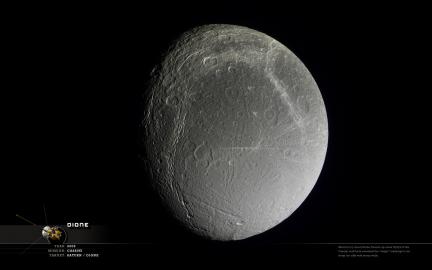 Saturn’s moon Dione seen at almost full disk. Recently the “wispy” markings have been revealed to be giant ice cliffs as seen by the Cassini spacecraft after coming close to 500km from the surface. The cliffs reach as high as several hundred meters high and are thought to be the result of ancient tectonic fractures.
Saturn’s moon Dione seen at almost full disk. Recently the “wispy” markings have been revealed to be giant ice cliffs as seen by the Cassini spacecraft after coming close to 500km from the surface. The cliffs reach as high as several hundred meters high and are thought to be the result of ancient tectonic fractures.
Image Processors on Flickr: Gordan Ugarkovic
Gordan Ugarkovic has a great collection of reworked Cassini images on Flickr. I contacted Gordan about showing some of his images here on wanderingspace and he was ever so gracious. As many people Gordan is “somewhat underwhelmed by the frequency the Cassini Imaging Team releases color composites”, so it is up to excellent freelancers like him to compile this information from the data files which are made public by NASA. Problem is that these images rarely make it to the mass media and we are stuck with the dozen or so color images the NASA imaging teams decide to produce in a year.
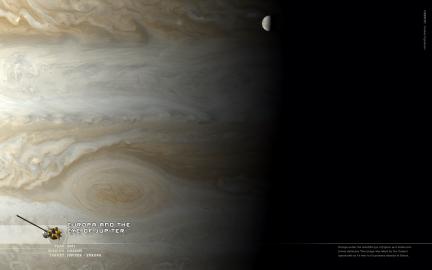
WALLPAPER NOTE: The left 1/3 of the “Three Moons” image was extended in Photoshop using data at the edges of the original image which was cropped to a square format. This “fake” imagery was only applied to that area of the rings and the rest of the image including the moons is actual.
Here are some other images from Gordan which are some of my favorites, but don’t trust my editing… go to the gallery and have a look yourself. For the sake of posterity I have added a permanent link to his gallery on the right side of this blog where you may note that there are already a few others linked. There were two additional ones but the sites have been taken down since I linked to them?! Hopefully the three left will stick around for a while and I will in time add more to the collection.
Tethys and Saturn’s Hazy Limb
Mimas and Prometheus on Rings
Io on Jupiters Edge
Wallpaper: Dione and Saturn
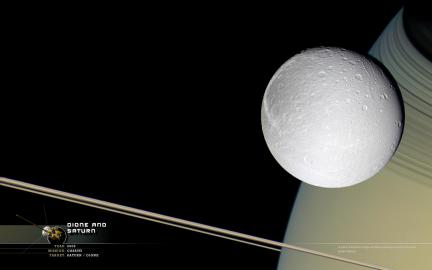 Dione’s most notable features are the wispy streaks which are seen here in the upper left-hand side. These have been determined to be “ice cliffs” and are now thought to reveal tectonic fractures just like those known on Earth to cause earthquakes.
Dione’s most notable features are the wispy streaks which are seen here in the upper left-hand side. These have been determined to be “ice cliffs” and are now thought to reveal tectonic fractures just like those known on Earth to cause earthquakes.
IMAGE NOTE: One of the best images returned from Cassini is this one of Saturn’s moon Dione passing in front of its host. Nearly hard to believe this is an actual image and not a composite. All that was added, or altered to this image was the extension of left side Saturn’s rings as they were cropped off in the square format of the original.
